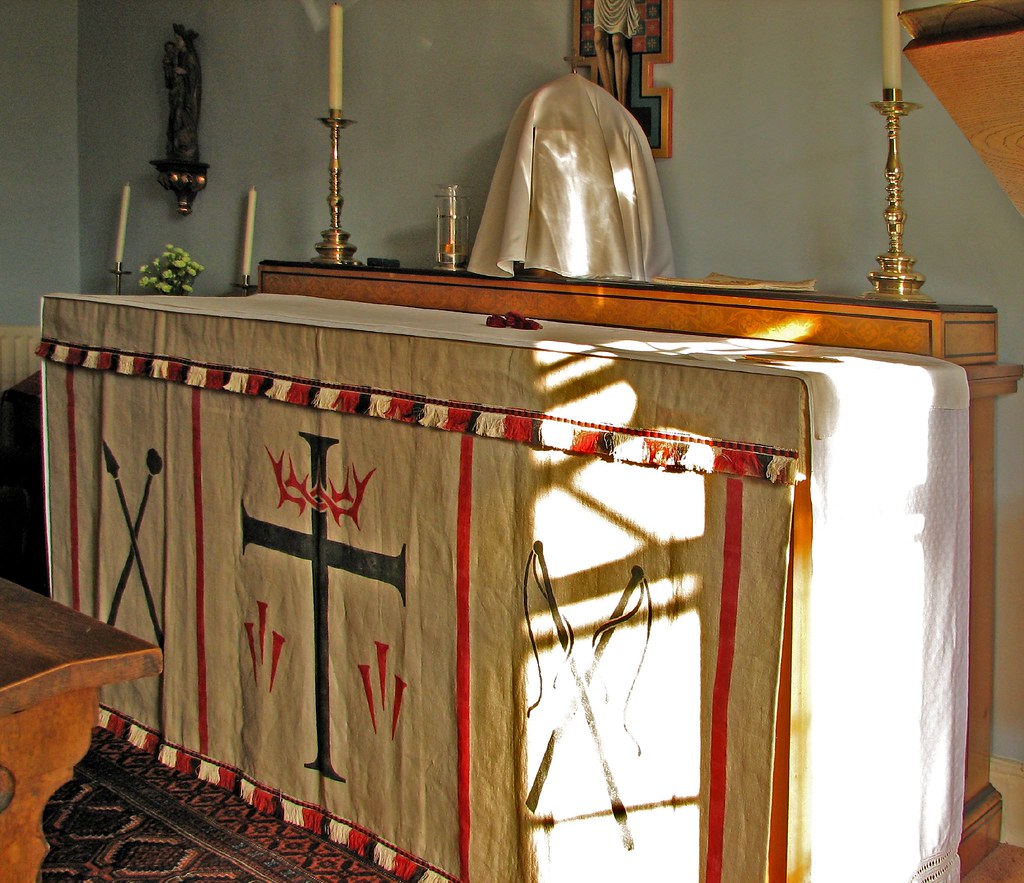
Lenten Array at Dorchester.
Photo: Fr Lawrence Lew, O.P.
Illustration: FLICKR
Lenten Array at Saint Birinus, Dorchester.
Photo: Fr Lawrence Lew, O.P.
Illustration: FLICKR
Fairford, Gloucestershire, originally uploaded by Vitrearum (Allan Barton).
The Lady Altar in the Tame Chapel, at Fairford, in Gloucestershire, has a Reredos
of 1913,
by Geoffrey Webb, covered during Lent with Lenten Array.
The Reredos Veil is decorated with a Central Rood Group, in Grisaille, with Ox-Blood
Stencelling around it. The Tabernacle containing the image of Our Lady, that forms an
Upper Level of the Reredos, is enclosed with doors and the backs of the doors are also
Stencilled. Sadly, these seem to be the extent of the surviving Lenten Array, the
Blue Frontal (Editor: Antependium) remains in place during Lent, as does the very Festal Dorsal
with its Armorial embroidery. Consequently the Lenten Veiling rather loses its impact.
Text and Illustration from MEDIEVAL CHURCH ART
The following Text is taken from NEW LITURGICAL MOVEMENT
The Author was Fr. Lawrence Lew, O.P.
However, in The Sarum Use, the Sacred images and the Altar were already Veiled on Ash Wednesday, and, rather than Violet Cloth (which would have been an expensive dye to acquire), Bleached Linen, with simple Lenten and Passion designs, are used: The idea was for a general negation of colour during Lent.
Lenten Array at Saint Birinus, Dorchester.
Photo: Fr Lawrence Lew, O.P.
Illustration: FLICKR
The following Text is taken from FULL HOMELY DIVINITY
The colour was Lenten White, which was natural linen material, sometimes referred to as Ash colour. According to "An Introduction to English Liturgical Colours": "The explanation of this use of White, which is closely akin to Ashen, is 'in this time of Lent, which is a time of mourning, all things that make to the adornment of the Church are either laid aside or else covered, to put us in remembrance that we ought now to lament and mourn for our Souls dead in sin, and continually to Watch, Fast, Pray, give Alms . . .' wherefore 'the Clothes that are hanged up this time of Lent in the Church have painted on them nothing else but the Pains, Torments, Passion, Blood-Shedding, and Death, of Christ, that now we should only have our minds fixed on The Passion of Christ, by Whom only we were redeemed."
This practice made a startling transformation of the Church, for the whole of The Lenten Season, so that Easter, literally, burst forth like The Lord from the tomb, when the Church was returned to normal state."
"Care must be taken that too many devices, or symbols, are not introduced on to the Hangings and Veils, or the austerity of The Lenten Symbolism will be lost, and it will give a 'Festive', rather than a restraining, atmosphere to the Interior of the Church."
Text and Illustration: TIMOTHEOS PROLOGIZES



No comments:
Post a Comment